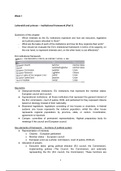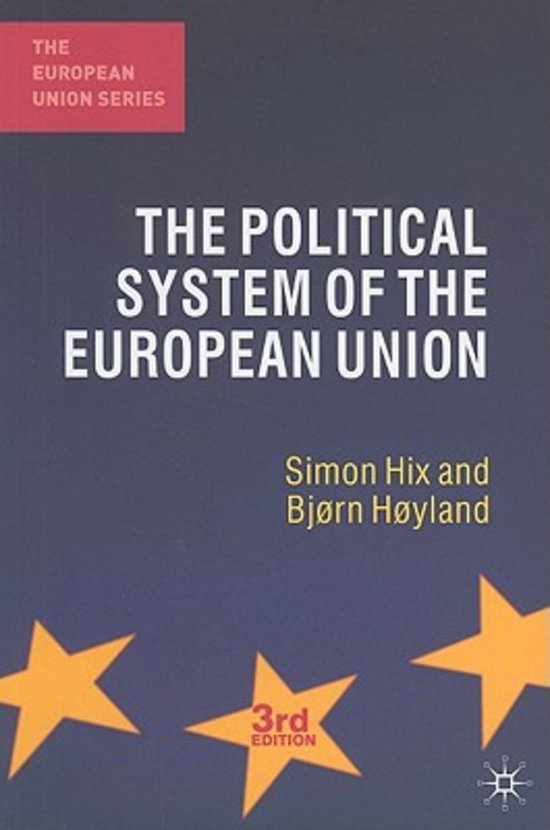Week 1
Lelieveldt and princen – institutional framework (Part I)
Questions of this chapter:
- Which interests do the Eu institutions represent and how are executive, legislative
and judicial powers allocated to them?
- What are the tasks of each of the institutions and how do they organize their work?
- How should we evaluate the EU’s institutional framework in terms of its capacity, on
the one hand, to represent interests and, on the other hand, to act effectively?
EU institutional framework
Key terms
● Intergovernmental institutions: EU institutions that represent the member states:
European council and council.
● Supranational institutions: all those institutions that represent the general interest of
the EU: commission, court of justice, ECB, and parliament bc they represent citizens
based on ideology instead of their nationality.
● Bicameral legislature: legislature consisting of two houses or chambers, in federal
systems one house represents the national population, whilst the other house
represents regional populations by province, state, or canton. Coordination,
agreement is important.
● Coreper: committee of permanent representatives. Highest preparatory body for
meetings if the council and European council.
Key elements of framework functions of political system
● Representation of interests
o Citizens European parliament
o Member states European council
o European union as a whole: commission, court of justice, ECB etc.
● Allocation of powers
o Executive tasks: giving political direction (EU council, the Commission),
implementing policies (The Council, the Commission), and externally
representing the EU (EU council, the Commission). These functions are
1
, performed by the EU council. The ECB has an executive role for
implementing monetary policies.
o Legislative tasks: examining, modifying, and adopting legislative measures
which provide the basis for EU policies. These tasks are shared by the
parliament and the council as similar to a system of bicameral legislature,
however, these bodies differ from other federal systems in the sense that they
do not have the formal right to initiate legislative proposals, this solely belongs
to the commission.
o Judicial tasks: interpretation of EU law as well as solving conflicts involving
EU institutions, member states and all other parties (Court of justice).
o Supportive tasks: court of auditors which examines EU revenues and
expenditures.
Major EU institutions
1. European Council
Most important, consists of heads of government (prime ministers); heads of state
(mainly France); the president of the EU council (chair, term of 2,5 yrs.); the high
representative of the union for foreign affairs and security policy; and the president of the
commission to ensure coordination between both bodies.
Tasks:
● Providing political direction: long term agenda setting in terms of internal,
common foreign, and security policies (e.g. climate strategy, long-term monetary
policies).
● Problem solver and ultimate arbiter: ultimate intergovernmental decision-making
body for issues that cannot be solved by the council (UK’s financial contribution
to EU).
● Treaty revisions: for ordinary revision procedures majority vote and for simplified
revisions unanimous vote.
● Appointments: appoints its own president, president of the commission, and the
high representative, latter two need to be approved by EP. Also appoint
members of the executive board of the ECB.
● Meets 4 times a year.
2. The council
Council of ministers represents the member states at the European level, legally one
council byt meets in different configurations. 80% of the decisions that make have
already been taken on lower levels: coreper 1 and 2; sectoral working groups. Rotating
council presidency, each member state government is president for 6 months. The
council has the say over EU policies, and it the major policy-making organ when it
comes to CFSP.
Tasks:
● Acts as legislator in terms of internal policies, concludes international
agreements.
2
, ● Has responsibility for the Eu’s external relations
● Executes the Common Security and Foreign Policy (CSFP) through adoptions,
conclusions, recommendations, decisions, and sanctions. They’re also able to
take operational measures and make the key formal decisions accession
procedure of new member states.
● Coordinates the macro-economic policies of the member states
● Concludes international agreements with third world countries in some areas.
Council configurations
3. The commission
Differs from other two in the sense that it promotes the general interest of the Union and
take appropriate initiatives to that end, for this reason commissioners are supposed to do
their work independently. The commission is headed by a college of commissions
consisting of 28 members.
● Organization: 28 commissioners, president of the commission plans and chairs
the meetings, work is organized in 40 departments (directorate generals DG’s0,
25k employees.
Tasks:
● Preparing and initiating legislation: in all areas except CFSP, has a monopoly to
do so.
● Implementing policies: administering the EU’s budget and keeping track of
revenues and expenses.
● External representation: e.g. trade negotiations
● Guardian of the treaties: monitors the correct application of community law and
the correct implementations of policies by member states and private actors.
3






